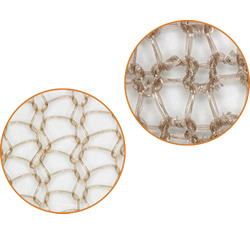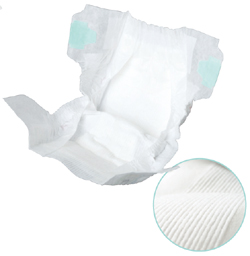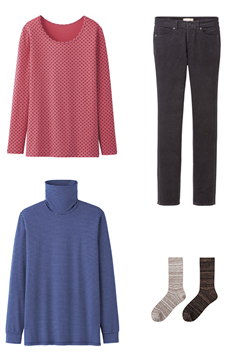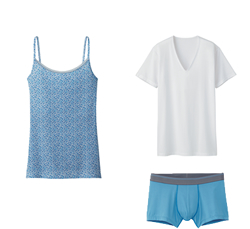niponica is a web magazine that introduces modern Japan to people all over the world.
2013 No.11

To read the e-book you need to have JavaScript enabled in your browser and a free Flash Player plug-in from Adobe Systems Inc. installed.
Japanese Fabrics Have Their Global Reputation Wrapped Up

Modern Fabrics for Today's Lifestyles
Fabrics with special functions, modern textiles born from expertise and advanced technologies... These pages show how traditional weaving techniques have always evolved, blending with ever-newer technologies to become today's fabrics, making our lives more convenient, comfortable and enjoyable.
Photos by Murakami Keiichi and Takahashi Hitomi
Collaboration: UNIQLO Co., Ltd., Atsugi Co., Ltd. and Unicharm Corporation

ASTIGU stockings made by Atsugi Co., Ltd. offer a woman the opportunity to match her mood as she chooses clothes for the day. One series, with the signature Hada mark, creates the impression of an invisible stocking yet comes in 12 colors, each a subtle shade different from the others to match skin color and clothing style.
Flattering for legs, and comfortable, too
Stockings of superlative quality

Right: The use of double nylon threads makes stockings more tear-resistant.
Left: Stockings designed for a transparent look are woven from single, thin nylon threads.
Stockings are a big item in Japan, a way to show neatness and respectability. Made-in-Japan stockings are known for their excellent quality, and now more and more of them are adding charm to women's legs in new ways. For example: some are chosen to match leg color, just as foundation cosmetics match skin color; some give the leg a slimmer look through the use of threads that stretch for a tighter, firmer effect; some use double threads to reduce the risk of ripping; some are woven with smooth threads for a transparent look; and others have all five toes. And then, for hot and humid weather, there are others that feature UV protection, or help eliminate odors and bacteria. Offering more comfort than a bare leg, and adding charm, as well—stockings made in Japan do this and more.
Cool in summer, warm on winter days
Innerwear evolves to serve multiple functions
A clothing manufacturer and two textile enterprises joined forces to develop different fabrics with an important role—keeping you comfortable both summer and winter.
AIRism undergarments let perspiration escape and prevent sticking, no matter what the season or situation. They are gender-specific, using different fibers to account for gender differences. For men, who tend to perspire more, the innerwear is made of ultra-fine polyester fibers that excel in perspiration absorption and quick drying. For women, who tend to feel cold as their perspiration evaporates, the rapid absorption of moisture is controlled mostly by cupro fibers. AIRism inner garments for both men and women have added substances that combat bacteria and neutralize odors, for comfort even in hot, humid environments.
A material called HEATTECH is great for winter undergarments because it protects against the cold by actually generating heat. A combination of four different fibers in the weave work like this: rayon fibers absorb water vapor from the body, and change it into heat energy; this generated heat is retained within acrylic fibers; meanwhile, polyester fibers ensure rapid drying of the absorbed moisture; and polyurethane fibers provide stretchable comfort. Garments made of HEATTECH are light, comfortable, and warm just by wearing them. At first, HEATTECH was intended only for undergarments, but now it is also used for clothing made from jersey cloth, and for jeans, socks and more. Worldwide sales of HEATTECH garments have reached more than 300 million items, and innovation continues.
* Please note that some of the products shown above are no longer being marketed.
A sampling of garments made from HEATTECH, which uses body moisture to generate heat. The fabric was developed jointly by UNIQLO Co., Ltd. and Toray Industries, Inc.
Functional AIRism undergarments marketed by UNIQLO Co., Ltd. Fabric for men's wear, developed by UNIQLO and Toray Industries, Inc., is known for its smooth touch and quick-drying comfort. Fabric for women's wear, developed in collaboration with Toray Industries, Inc. and Asahi Kasei Corporation, also offers a smooth touch, and in addition helps to prevent cooling caused by evaporating perspiration.
Paper diapers for baby comfort
Gentle on the skin, and a just-right fit

Above left: This paper diaper, brand name "moony," is made of SOFTRETCH® fiber. The manufacturer, Unicharm Corporation, is known for its high-quality sanitary products and disposable diapers. The company invested 12 years of research to perfect this type of diaper.
Bottom right: Sheet made from fine fibers. Even after the diaper absorbs moisture, the surface facing the baby's skin remains dry.
Infant skin is said to be only about half as thick as adult skin. Disposable diapers made of paper, unlike woven cloth, have short fibers, so they are generally hard to the touch and cannot stretch. If a baby wears paper diapers day in, day out, the skin tends to become chapped and subject to diaper rash. These disadvantages led to the development of a new material, SOFTRETCH®. Its fine fibers are made into a non-woven fabric, which is combined with another non-woven fabric that can expand and contract. This results in a material that is soft on the skin and adjusts its shape to match body shape. The diaper fits the form of the baby's body, remaining flexible as it moves, and therefore reducing the risk of chafing. "Gentle to a baby's skin" is always the ideal, and these paper diapers are the reality.




